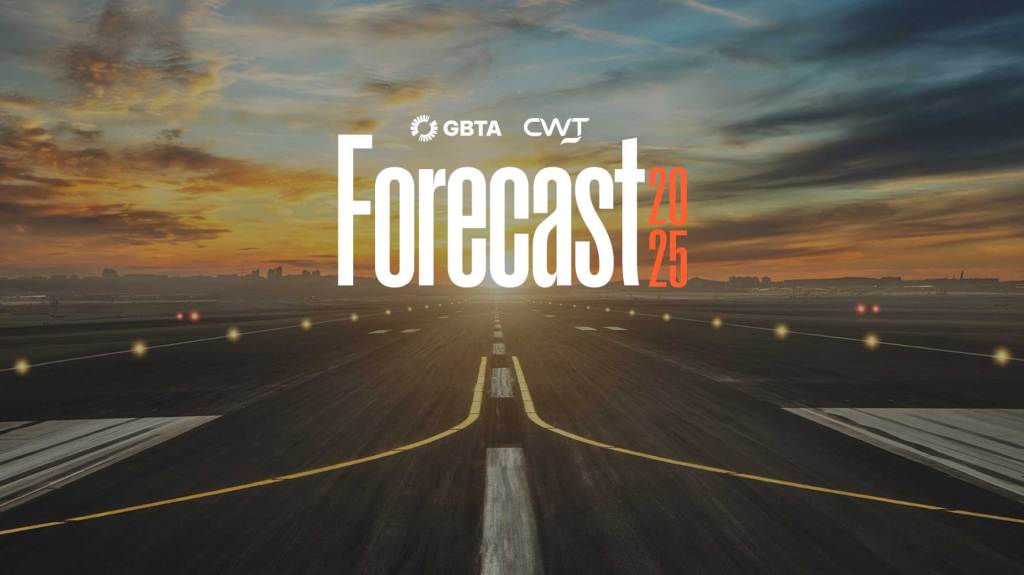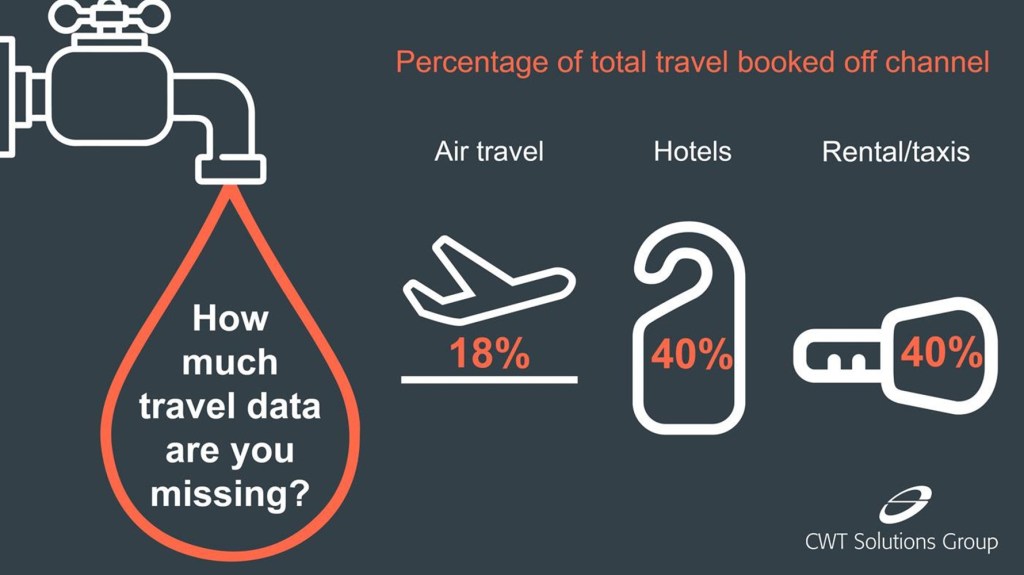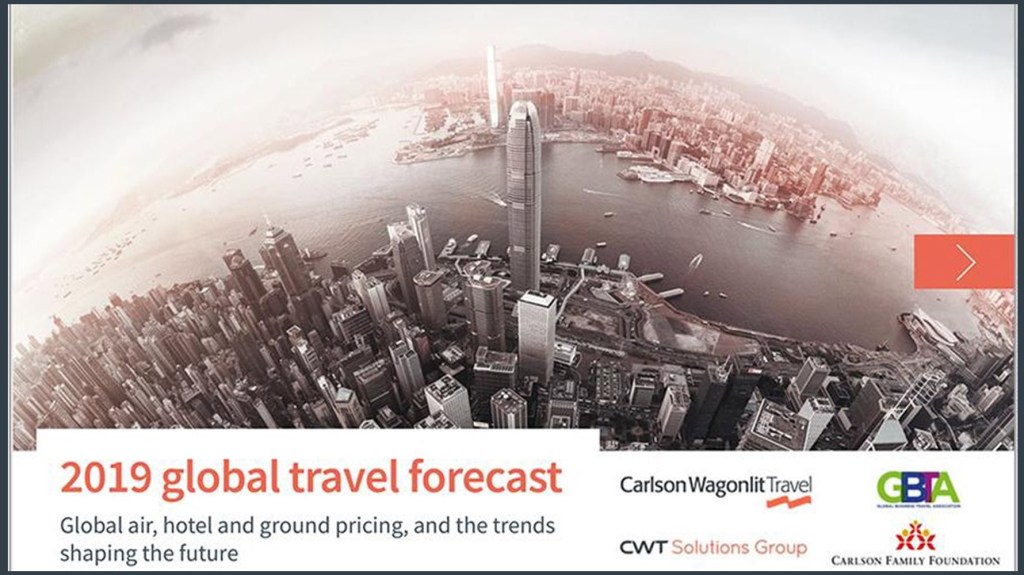Introducing the latest myCWT product and service enhancements
Building on our digital, omnichannel myCWT platform, our new products and services will simplify travel management for you and your employees – anytime, anywhere, anyhow.
Note: Featured services may not be available in your country at this time. Please reach out to your CWT representative for more details.
Hear from Chief Product Officer, Erica Antony as she shares the key product highlights of 2024, along with the key areas driving innovation.
-

2040: Baseline, Boom or Bust
As we enter an era of rapid transformation and unprecedented challenges, it is essential for travel managers, meeting & event planners, and corporate decision-makers to look ahead and frame our current strategic thinking with a clear vision of the future. Business travel and meetings and events (M&E) are poised for significant change over the next decade and a half, driven by a complex interplay of sustainability goals, technological advancements, evolving work models, and geopolitical dynamics.
In this paper to mark the 10th anniversary of our Global Business Travel Forecast, we explore, for the first time, a long-term vision of the future and potential trajectories through three distinct scenarios, each offering insights into how these forces should affect policy-making, budgeting and priorities. By examining these scenarios, we can better understand the diverse possibilities that lie ahead and the strategic imperatives required to thrive in each potential future.
Based on trajectory data analysis and interviews with industry leaders, behaviorists and climate tech founders, this forward-looking approach enables us to anticipate changes, strengthen our strategies, and make informed decisions that align long-term objectives. It is through this lens of foresight and adaptability that we can build resilience, seize opportunities, and navigate the complexities of the future.
We invite you to reflect on the insights presented, and consider how your organization can prepare for the opportunities and challenges that lie ahead. Together we can ensure that travel and meetings remain catalysts for growth, scalability and sustainable practices.
- Scenario development is both an art and a science
- Megatrends Shaping the Future of Business Travel, Meetings and Events
- Sustainability goals the new crux of corporate policy
- Technology Revolutionizes Travel Management
- Modern work models spark new travel patterns
- Changing demographics open doors to new opportunities
- Three Scenarios: Base case, boom and bust
- Future-proofing strategies

-

CWT GBTA Global business travel forecast 2025
When it comes to pricing, global business travel has finally reached an enduring, higher baseline. Prices will continue to rise in 2025, but only moderately, so expect a period of normalized growth.
However, this pricing environment, one of marginal gains and price regularity, is fragile. Global leisure travel has now realized a lot of its pent-up demand, while corporate travel has been resurgent, with 2024 edging at preCovid levels.
There are many factors at play, whether its volatile oil prices, labor costs and constraints, inflationary pressures, and geopolitical factors. As this elevated baseline edges upwards, albeit marginally, travel budgets will come under increased scrutiny, especially as travel patterns and attitudes change.
It’s why business travel can’t be viewed in a silo, and the true value to an organization must be fully realized. This forecast can help with those calculations.

-

Capitalize on emerging technologies in corporate travel
Technological advancements are accelerating at an unprecedented pace. How will emerging innovations like Generative AI, blockchain, and self-sovereign identity (SSI) transform corporate travel?
BTN and CWT probed global CEOs, travel managers, industry consultants and tech experts on the promises, questions, and expectations these innovations raise and how they are set to reshape traveler experience, cost control and service delivery in corporate travel and events.
Download and discover
- The technologies that will have the greatest impact on corporate travel in the next 2-5 years
- How these emerging technologies are poised to control costs, enhance service and security, and boost efficiency
- The critical challenges, opportunities, risks and roadblocks each innovation raises
- What travel managers, buyers and experts anticipate from these innovations

-

Top tips on how to plan a business trip
Follow these 6 steps for an effective business trip:
- Make your travel arrangements well in advance
- Select your accommodation based on both price and convenience
- Create an itinerary
- Research your destination
- Remember your electronics, accessories and travel documents
- Prepare for your meeting
In today’s digital world, we can communicate across different time zones at a moment’s notice. However, when it comes to brokering a big deal or fostering a solid and long-lasting business relationship, nothing beats face-to-face interaction.Corporate travel is still so important, and it’s equally important for anyone making a business trip to prepare thoroughly. When you arrive at your destination relaxed and well-prepared, you’re better equipped to make a good impression and focus on the purpose of your meeting. Preparation lets your mind focus on the here and now, making sure you stay on the ball in that all-important meeting. If you’d like to fine-tune how you get ready for your next excursion, follow these essential tips to become an effective business trip planner.
Make travel arrangements
Whether it’s your name on the travel documents or you’re a travel manager, planning business travel thoroughly is important. Your first step should always be to familiarize yourself with your company’s corporate travel policy. You’re making travel arrangements for a business trip, not planning a personal or a short break, so being compliant with your company policy is essential.
Next, it’s time to book your travel. This may involve traveling by air, rail, car hire or even boat. Think about the journey door-to-door, balancing travel times against cost and convenience. Visualize the various steps of the trip from A to B. Consider details like how long it will take to move between airport and railway station, the time it takes to fill out paperwork at the vehicle hire company, and whether luggage storage might be useful. Use multiple sources and different comparison sites, researching which companies are offering the best deals. Again, be aware of any budget restraints in your company’s travel policy.
Don’t forget the small details. Does the airplane have Wi-Fi so you can work on the move? Would leaving a day earlier allow you to arrive at your first meeting better rested and prepared? At this stage, the more carefully you prepare, the more confident and relaxed you’ll be when you depart.
Select your accommodation
Preparing business travel is, of course, only half the job. Choosing the best accommodation for your requirements is also essential. If you’ve only got one meeting place to reach, make sure you book a hotel that’s nearby – rather than be swayed by a more luxurious option that might be a stressful 45 minute trip away. Use maps on your smartphone to measure distances from the station or airport to your hotel – and remember the roads and transport networks will be busier at certain times of day.
Check your company’s hotel policies to see if there are any preferred hotels – you might be able to get a good deal too. When considering the cost, make sure you compare rates for similar types of accommodation and make sure you select something that’s fairly priced – some companies even stipulate a cost per day that would limit the choice of hotels.
It’s also a good idea to pay close attention to the amenities at the hotel. Some tourist-focused hotels may serve breakfast too late for your early starts, and as a business traveler you’re likely to want free Wi-Fi, 24-hour room service, plenty of power points for charging your devices. CWT Hotel Intel gives travelers access to trusted peer hotel reviews and can be a handy tool for business trip planners.
Create a detailed itinerary
Your itinerary is your blueprint for a successful business trip. Use it to stay in control of every detail – from transport times and the names of those you’re meeting, to your travel reservations and hotel address. Be sure to allow yourself extra time on your itinerary for relaxing, meetings that have been delayed or overrun, and busy traffic. Consider using a specially designed tool like the myCWT app, which syncs your itinerary with work calendars, and allows travelers to share this with colleagues. This is handy from a communication and efficiency perspective, and as a safety measure if you’re travelling to an unfamiliar destination.
Research your destination
It may be that you’re traveling to a destination you are familiar with and feel comfortable in. Or, you may be entering unchartered territory. If that’s the case, research is essential to avoid unnecessary risk. For example, some cities are well known for pick pockets, so you’ll need to be extra careful when storing important and expensive items like phones in your pockets. Depending on where you’re going, reading up on the current political situation at your destination could also be prudent.
Perhaps you’re traveling to a city or country with a different culture and customs to your own. Avoid looking foolish or, worse, causing offence, by researching the differences in behavior and manners before you arrive. For example, if you’re taking potential clients for a meal, do you know the etiquette on tipping, or when to give people your business cards? Or, if you’re visiting a country where English isn’t the common language, you could even learn a few basic phrases, such as greetings and “thank you”, which could make all the difference when making a good first impression.
Prepare your travel documents
Hours of careful preparation and research will all be wasted if you forget vital travel documents. Traveling between countries requires a current, valid passport, travel tickets and sometimes a visa. It’s key to research whether or not you need a visa as soon as possible, even if you are just transiting through a country, without stepping foot outside the airport. Some embassies can take a number of days or even weeks to issue visas. Even if you’re not traveling to a different country, you may need photo ID to clarify that your name corresponds to the one on the ticket – your passport or driving license are the best options so keep them safe at all times.
Remember your electronic accessories
Stay as productive as possible on your trip by taking a laptop or tablet – it’ll make your travel time really count. Remember to pack the relevant chargers and adapters, too. You can usually pick these up at the airport when you’re passing through, but being prepared is key and will save you time and money in the long run.
Get ready for your meeting
So you’ve followed all the right steps for planning a business trip, but what about your business objectives and the meeting itself? Making a note of what you hope to achieve on the trip can help improve your focus – even if you simply want to reach out to new contacts or gain a general overview of potential new client. Arm yourself with as much information as possible about the people you’ll meet, as well as the places they’ll be. What’s the dress code? If you’re visiting an industrial site, for example, will you need sturdy shoes? If you’re going to be giving a presentation, what format will it take and will your host have the equipment you need? Simply emailing ahead to check if they have suitable screens and cables can ensure you avoid embarrassing delays or confusion that would get your meeting off to an awkward start. That first impression counts so give yourself the best chance of making a good one.
By setting aside the time to prepare, conducting some detailed research and following these business travel tips, you can optimize your chances of a productive and enjoyable trip.
-

Carlson Wagonlit Travel launches CWT Travel Consolidator, providing full visibility on travel spend
Carlson Wagonlit Travel, the global travel management company, has launched CWT Travel Consolidator, an analytics tool that captures every part of an organization’s travel and expense spend, helping travel managers make the right decisions, and saving clients money.
“Gathering, matching and reconciling travel and expense data is challenging and it’s often hard to get the full picture of the total cost of a trip,” said Christophe Renard, Vice President, CWT Solutions Group. “CWT Travel Consolidator gives you that visibility – and can save up to 7% on travel costs.”
The web-based platform combines air, hotel and ground transport transactions booked through the TMC with credit card, expense and HR data. This reveals the hidden costs of business travel and off-channel spend, enabling travel managers to identify missed savings opportunities, improve compliance and increase organizations’ negotiating power with suppliers.
CWT Travel Consolidator’s data algorithms consolidate, standardize and clean up the data, saving travel managers the time and hassle of having to fix inaccuracies. Having all their data on a single platform, with configurable dashboards and reporting capabilities, means travel programs can be more efficiently managed with all card, travel and expense data integrated in one place.
Integrated data also provides valuable information on spending outside official channels such as flights and hotels booked on personal cards and poorly understood costs like airline seat selection charges, meals, laundry and incidentals. CWT Travel Consolidator not only reveals these costs but also attaches them to the trips and travelers who incurred them. Costs can be then be cut, reported and analyzed by trip, cost center, organizational structure, route, on vs off-channel, and supplier. That makes the data much more manageable, delivers insights, and ensures travel policies remain fit for purpose even as circumstances change.
A CWT-sponsored survey by the GBTA Foundation found that 64% of travel managers feel they don’t have enough data to calculate the total cost of a trip. Nearly three-quarters (73%) struggle to reconcile differences in reports due to data formatting, while 58% said they spend too much time reconciling and cleaning data.
To help travel managers get the most out of the tool, CWT has a team of 160 travel sourcing and optimization consultants who can advise clients, enabling them to make sense of their data and take informed decisions to improve their travel programs.
Carlson Wagonlit Travel
Companies and governments rely on us to keep their people connected. We provide their travelers with a consumer-grade travel experience, combining innovative technology with our vast experience. Every day, we look after enough travelers to fill more than 260 Boeing 787s and 100,000 hotel rooms – and handle 105 events. We operate in around 150 countries, and in 2017 posted a total transaction volume of more than US$ 23 billion.
-

4 ways that companies can fight human trafficking
The travel industry is a wonderful sector in which to work – but criminals abuse air travel, hotels, and events, to conduct hideous crimes against humanity.
Everyone knows that the trafficking of people is an illegal and fundamental violation of human rights in every country in the world. Despite that, it can still be difficult for the private sector to have the courage to put their brands behind this issue.
Today, 30 July, is the United Nations’ World Day against Trafficking in Persons. Every country in the world is affected by human trafficking, whether as a country of origin, transit, or destination for victims. There are millions of victims in the world today.
Let’s use this day to focus on four ways that companies can assist in the fight against these horrific practices:
1. Help those already on the battlefield
Many organizations already fight such criminal activity, so show your company’s values and reach out to support the likes of:
- ECPAT, a global non-profit organization working to protect children from trafficking, sexual exploitation, and online abuse.
- World Childhood Foundation, which supports more than 100 international projects, focused on preventing abuse and child exploitation.
- The Orphaned Starfish Foundation, which helps orphans, victims of abuse and trafficking, and at-risk youth break the cycle of abuse and poverty through computer-based education, job training, and job placement assistance.
- Thorn, which builds technology to defend children from sexual abuse, thus resonating with our own digital strategy.
- TrustLaw, an organization that provides pro bono legal advice to not-for-profit organizations that fight modern slavery and human trafficking around the world.
2. Reinforce your company’s policies
Ideas which resonated with our organization include:
- Establishing an anti-human trafficking task force, comprising colleagues from all regions and functions.
- Ensuring our code of conduct encourages employees, partners and the broader business community to take a stand against human trafficking.
- Reviewing the supplier code to meet the requirements of the UK Modern Slavery Act, and preventing any form of modern slavery in the supply chain.
3. Increase employee awareness
Employee engagement is critical, so look at ways of achieving this. Some ideas that have been proven to work include:
- Introducing Businesses Ending Slavery and Trafficking (BEST) Employers Alliance training, to help employees better understand and recognize the issue.
- Creating a dedicated intranet section on human trafficking/modern-day slavery.
- Hosting meetings with a partner (see 1, above).
- Creating fundraising events to capture the imagination, such as
- Encouraging colleagues to walk enough steps to circle the globe.
- Entering teams for events such as cycle rides, marathons, or bake-offs.
- Being in travel we have also included over half a million travel alerts on electronic tickets issued in the US to destinations where there is a prevalence of child sex tourism.
4. Collaborate closely with stakeholders and public leadership
This year, Carlson was a sponsor of the Super Bowl Anti-Sex Trafficking Committee, made up of representatives from locally-headquartered global businesses.
And while public focal points like that may not happen all year round, why not get key business leaders to participate in high-profile industry events, which for us include the likes of the UN World Tourism Organization meeting in NY on the fight against child sexual exploitation in the tourism sector.
The fight against human trafficking is a cause that CWT feels very strongly about. Everyone has the right to a decent and safe life, free from slavery, and hopefully businesses like ours can help make that a reality.
This post contains just a few thoughts on how companies can help – and we’d love to hear other ideas to inspire us.
In the meantime, if you are interested to find out more about Human Rights at CWT read our Responsible Business Report.
-

Buoyant global economy means higher hotel and air prices in 2019
Travel prices are expected to rise sharply in 2019, with hotels going up 3.7%, and flights 2.6%, driven by a growing global economy and rising oil prices, according to the fifth annual Global Travel Forecast, published today by GBTA and CWT with the support of the Carlson Family Foundation.
“While most major markets appear to be trending in the right direction, downside risks remain for the global economy given the rise of protectionist policies, the risk of stoking trade wars and Brexit uncertainty,” said Michael W. McCormick, GBTA executive director and COO. “This forecast provides travel buyers with a better understanding of the global market and key price drivers demonstrating the key to building successful travel programs will be watching and reacting to an ever-changing global landscape.”
“Prices are expected to spike in many global markets even as inflation remains subdued,” said Kurt Ekert, President and CEO, Carlson Wagonlit Travel. “The report explores the causes and includes an overview of what we expect to see in key markets worldwide. It also gives specific recommendations, giving travel managers ammunition for their upcoming negotiations.”
Released today by the Global Business Travel Association, the voice of the global business travel industry, and CWT, the global travel management company, the 2019 forecast also shows the trends and developments that will shape the business travel industry.
“The future of corporate travel can be summed up as accelerated personalization – with mobile technology, AI, machine learning and predictive analytics all playing their part,” said Ekert. “Success is tied to technology, with sophisticated data-crunching at the very heart of it.”
2019 air projections
The aviation sector will be shaped by the introduction of ultra-long-haul flights and an increasing competition from the low-cost carriers, which are not only multiplying but also fighting for long-haul routes – and by the airlines’ push towards NDC.
Airfares are likely to become more expensive due to rising in oil prices, the competitive pressure from the shortage of pilots, potential trade wars, and increasing fare segmentation to improve yield.
Asia Pacific expects to see a 3.2% rise in 2019 pricing. Chinese demand remains high and by 2020 the country is expected to become the world’s biggest air travel market. In 2019 the country’s flights are seen going up 3.9%. But China will not be alone. The vast majority of countries in the region will see price rises, especially in markets like New Zealand (7.5%) and India (7.3%). The latter is expected to be the world’s third largest aviation market by 2025, with airports operating beyond capacity. The only exception in this booming region is Japan. Prices there will likely drop 3.9% due to the country’s added capacity in preparation for the Olympic Games in 2020.
Across Europe, Middle East & Africa, air travel is anticipated to continue growing in Western Europe, with prices rising 4.8%. The increase will be especially pronounced in Norway (11.5%), followed by Germany (7.3%), France (6.9%) and Spain (6.7%). Eastern Europe and the Middle East & African countries, on the other hand, will experience a decline of 2.3% and 2% respectively.
Prices across Latin America are expected to drop 2% in 2019. However, México and Colombia will see slight increases –0.1% and 1.2% respectively– while Chile will experience a rise of 7.5%.
North America will see prices rise by a modest 1.8%, according to our projections. In the US, airlines are recalibrating to reflect better areas of demand, depending on how trade relationships change with key US allies and adversaries. The US aviation market is expected to see capacity compression due to expanded fare fragmentation, with premium economy and basic economy reducing available seats, as carriers target margin improvement.
2019 hotel projections
The hotel outlook for 2019 is driven by the overall increase in air travel, which will fuel demand for rooms. Technology will also play an important part. Hotels are introducing new developments to personalize the guest experience. The increase of mobile penetration, on the other hand, is forcing travel managers to offer their travelers apps, which also serve to accommodate greater in-policy booking autonomy.
Further mergers – and upscale hotels competing with midscale ones due in part to a growing appetite for boutique accommodation among younger travelers – will also be on the agenda.
In Asia Pacific, hotel prices are likely to rise 5.1% –with a large discrepancy as Japanese prices are expected to fall 3.2%, but New Zealand is set to rise a whopping 11.8%. In Australia, 2019 and 2020 are expected to bring the largest number of new rooms becoming available, with an increase of 3.4% of total supply each year. In Indonesia, Swiss-Belhotel International is embarking on an expansion of its budget brand, Zest Hotels, with plans to triple its portfolio of properties within three years. Singapore is embracing technology and smart hotels are on the rise. In Thailand, optimism is running especially high after a period of political tumult.
Mirroring air prices, hotel rates across Europe, Middle East & Africa are expected to rise in Western Europe 5.6%, while declining 1.9% in Eastern Europe and 1.5% in the Middle East & Africa. Again Norway will lead with a rise of 11.8%, followed by Spain (8.5%) –expected to replace the US as the world’s second most popular destination, Finland (7.1%) and France and Germany (6.8%).
Within Latin America, hotel prices are expected to fall 1.3%, with declines in Argentina (-3.5%), Venezuela (-3.4%), Brazil (-1.9%) and Colombia (-0.7%). However, Chile, Peru and Mexico are expected to see 6.4%, 2.1%, and 0.6% increases, respectively.
In North America hotel prices will go up 2.8% — 5% in Canada and 2.7% in the US.
2019 ground transportation projections
Next year, ground transportation pricing is expected to rise only 0.5% globally. However, by the fourth quarter of 2019, we will see a concerted effort by rental companies to raise prices.
2019 will also see a growing preference among travelers for ride-hailing apps while interest in high-speed trains is fading, due to high network costs and low-tech distribution systems.
Mobile mobility will rise. On-demand, shared, electric and connected cars will all become more popular. Connected car technology has the potential to change the entire automotive industry.
- In Asia Pacific, markets like New Zealand (7.5%), India (3.3%) and Australia (1.1%) will see increases. In China, giant Didi Chuxing is making big bets on autonomous driving. This year, Uber has sold its Southeast Asian business to Singapore-based Grab and Indonesian Go-Jek is expanding to Vietnam, Thailand, Philippines and Singapore.
- In Europe, Middle East & Africa, countries like Finland (1.9%), Norway (5.2%), Denmark (1.9%), Germany (3.2%) and Italy (5.2%) will see prices rise, while Spain (-0.4%), France (-0.5%), the UK (-3.5%), Belgium (-4.1%) and Sweden (-15.8%) will see decreases.
- Prices in Latin America also show a mix, with Argentina (4.3%), Chile (10.8%) and Mexico (5.8%) increasing, while Brazil drops 2%.
- In North America, Canada is expected to see a 5.2% increase in 2019, with the United States showing a slower 0.7% growth. In the U.S., the Audi-owned, app-based car rental service, Silvercar, continues its aggressive expansion. The company offers mobile-first car rental without the lines and paperwork.
About the 2019 Forecast
The projections in the 2019 Global Travel Price Forecast are based on:
- A statistical model, developed by GBTA with market and economic research firm, Rockport Analytics, that evaluates historical price behavior and forecasts future price references.
- The market-specific expertise and travel industry knowledge of CWT and CWT Solutions Group personnel worldwide.
- Information sourced from Moody’s Analytics, the International Monetary Fund Research Department, the United Nations and other leading organizations.
- Projections are based on transaction data from CWT’s global client portfolio, including anonymized client travel patterns, over the past seven years. Key macroeconomic and per-country indicators, such as current and expected GDP growth, the consumer price index, unemployment rates and crude oil prices, were used in the statistical model, as well as key supply-side drivers sourced from OAG and STR Global. All air statistics represent point of origin and include all trip types.
Global Business Travel Association
The Global Business Travel Association (GBTA) is the world’s premier business travel and meetings trade organization headquartered in the Washington, D.C. area with operations on six continents. GBTA’s 9,000-plus members manage more than $345 billion of global business travel and meetings expenditures annually. GBTA delivers world-class education, events, research, advocacy and media to a growing global network of more than 28,000 travel professionals and 125,000 active contacts. To learn how business travel drives lasting business growth, visit www.gbta.org.
CWT
Companies and governments rely on us to keep their people connected. We provide their travelers with a consumer-grade travel experience, combining innovative technology with our vast experience. Every day, we look after enough travelers to fill more than 260 Boeing 787s and 100,000 hotel rooms – and handle 105 events. We operate in around 150 countries, and in 2017 posted a total transaction volume of more than US$ 23 billion.
Follow us on Twitter, Facebook and LinkedIn.
Carlson Family Foundation
This forecast is made possible by the Carlson Family Foundation. Established in 1950, by its founder, Curtis L. Carlson, the Carlson Family Foundation represents the commitment of the Carlson family to give charitably to humanitarian and community affairs. Through investments in education, mentoring, children and youth at risk, youth mentoring, anti-trafficking initiatives, and workforce development programs, the Carlson Family Foundation actively participates in creating strong and healthy communities, and a competitive workforce.
-

How to navigate business travel in 2019
“May you live in interesting times,” former U.S Attorney General Robert F. Kennedy famously said in 1966.
Indeed.
It can feel like we popped a Mentos in a bottle of Coke. There’s Brexit, potential trade wars, the Antarctic melting faster than a forehead full of black market Botox.
Supposedly, the phrase is an ancient Chinese curse.
But it doesn’t have to be a curse.
Now is also a time of accelerating advances in all fields, that are increasing life expectancy and giving millions of people the chance to do things for the first time like travel on a plane or access the internet. We’re looking at growth in the global economy of 3.4%.
Not bad.
There’s the polarizing stuff too – things that are either going to make the future one long bottomless brunch or truly Dickensian, depending on your views: Bots, driverless cars, and robot receptionists.
And amongst it all, there’s you – Just trying to figure out how to carve out your corporate travel program for 2019.
We’re excited to help you navigate the uncertainties and put you one step ahead with the 5th annual Global Travel Forecast from Carlson Wagonlit Travel (CWT) and the Global Business Travel Association (GBTA). We uncover market and economic trends, industry intelligence and price projections for the year ahead.
Access:
- Why travel pricing is expected to rise sharply in 2019
- The technology that will shape the future – From AI and Blockchain to the start-ups shaking up corporate travel
- Pricing predictions for air, hotel and ground transportation – sliced and diced by region.
- Top tips and key risks for travel buyers from our experts
Sometimes it’s fun to live in interesting times. As long as you have a proper compass.
-

Travel and meeting consolidation in Asia Pacific – Getting the best of both worlds
Asia Pacific has always been a region made up of many sub-regions. Greater China, Southeast Asia, North Asia and the Oceania, all of which encompasses unique market nuances and business culture. Whilst cyclical economic impact deals an occasional blow to these markets, one could agree dynamic growth is one common characteristic cutting across the Asian economies. Riding the growth trend, corporates are rapidly expanding their market share in the region especially in key countries such as Myanmar, Cambodia, Vietnam and Philippines. The same corporates are also venturing further away from the tier one cities in the likes of China and India where huge opportunities reside. Such demand has undeniably fueled massive requirements for business travel and meetings both domestically and internationally.
Compared to the Americas and European markets, consolidated travel and meeting programs in Asia Pacific have been somewhat blooming at a later stage. Both programs seems to take on two parallel routes never to meet. However, change being the only constant, industry players are seeing a major shift in the Asian markets within the last couple of years. Travel and procurement specialists are increasingly seeing the benefits of consolidation as opposed to isolation. Stricter compliance, higher cost leverage, stronger customer service and greater alignment with strategic objectives have been the driver of such integration.
The call for greater ease and streamlining of processes and systems in booking transient travel or meetings have never been bigger. Increasing spend and volume ‘leakages’ as a result of the fragmentation in both programs have also been a longstanding concern in the procurement community. Finally, the lack of combined visibility across travel and meeting spend data gives consolidation a final push especially in key Asian markets with significant volumes such as China and India. The ability to achieve visibility and strategically leverage on key spend data becomes the driving force pushing towards consolidation. In many Asia Pacific markets, the obstacle to program integration can be largely attributed to factors such as; corporate inertia, lack of executive sponsorship, stakeholder resistance, perceived absence of suitable technology, or quite simply, not knowing where and how to commence.
Bringing both programs together can result in corporates getting the best of both worlds, and definitely a bigger procurement leverage. The transient hotel and meeting venue programs would be one example, where both segments would possibly have similar set of safety and security, compliance, and booking requirements. Imagine a scenario where your traveler no longer need to worry about the different processes in booking his travel either for a client visit in Hong Kong, or to attend an international congress in Amsterdam. There are no wrong doors that he could possibly be knocking on. For the travel manager, he or she is able to gain visibility and ultimately have an accurate assessment of the cost mix based on all the data that have been consolidated through technologies that speaks to each other either at the front or back end.
Big win for the corporate travel executive, bigger win for the business traveler.

-

Not without my smartphone – Are boomers the millennials of corporate travel?
Whether we travel for business, leisure, or even bleisure, the days of setting off on a journey without our mobile devices, and especially our smartphones, are a thing of the past.
I recently read a study which found that global smartphone dependence continues to grow, with a quarter of millennials looking at their phone more than 100 times a day. That’s once every ten minutes during a 16-hour waking cycle.
It would seem that millennials are far more dependent on their phones than older generations (boomers check their phones about a tenth of that time).
Our own research backs this up. 84% of travelers surveyed in Asia Pacific and The Americas, and 83% of Europeans, always bring a cell phone with them while traveling. So to be expected.
However, the unexpected findings came when we looked at the age split. The percentages rose to 90% in Asia Pacific and America, and 95% in Europe for boomers; compared to 85% in Asia Pacific, 86% in the Americas, or 82% in Europe for gen X travelers. Millennials scored the lowest rates with 77% in Asia Pacific, 76% in Americas and 75% in Europe.
Surprisingly, when it comes to traveling, it seems the older you are, the more dependent on your phone you become. Indeed, across regions and ages, we found that business travelers viewed their cell phone as the most important device to bring along. Again, boomers were the most attached to their phones, with 90% in Asia Pacific, 91% in the Americas, and 94% in Europe never wanting to be apart from their device. For gen X travelers, the results were 84% in Asia Pacific, 85% in the Americas, and 82% in Europe. Millennials scored just 75% in Asia Pacific and 74% in the Americas and Europe.
After examining these findings, one cannot but wonder, are European boomers the real millennials of corporate travel?
But it gets even more bizarre in the first study I mentioned. According to the findings, “global smartphone users won’t give up their device for one month, even if they were offered a day with their favorite celebrity (74%), a 10% salary increase (56%), an extra week of vacation (50%), $1,000 dollars (41%) or a holiday at their dream destination. They would also give up family, friends or sex for a week before their smartphone. 4% would even go to prison for a month to not lose their smartphone for a year.”
I am not sure that anyone should love a piece of technology that much.
-

Business travel in Gandalf’s shoes
My colleague Eric Tyree shed some light on predictive analytics, so there’s no need for me to dive into definitions and theories. Let me take the pragmatic approach instead and share with you some of the coolest developments we’re working on at the moment. We may not be Gandalf, the wizard from Lord of the Rings, but data enables us to create our own magic.
“A wizard is never late, nor is he early. He arrives precisely when he means to,” Gandalf famously said. A pilot we’re running with machine learning company Flyr enables us to do just that. We buy before a ticket goes up in price or wait because we know it’s going to go down. The proof of concept shows us this can make around two percent of travel savings appear. Magic!
On the hotel front, we’re starting to work with a different startup on a similar project but looking at hotel prices. As with Flyr, timing is everything, and making the reservation at the right time can make four percent of hotel costs disappear.
Both partnerships, along with CWT Price Tracking, will enable us to implement the most efficient and sophisticated air booking and hotel booking processes in the world. The great thing about this is – and here comes the magic – the analysis is running in the background, completely invisible to the traveler, who does not need to worry about a thing.
Less choice, not more
There’s also a lot of data-enabled magic around the personalization of our customer interface, myCWT. Throwing up 5,329 hotels and 1,289 flights for a trip from Barcelona to Paris when we know our client is going to be there at 9:00 am, stay two days at the hotel next door to his office, and be back at 7:00 pm makes no sense. Refining the results each traveler will be able to see based on stored knowledge is the next-level personalization our predictive analytics offers to clients.
What to do with the time
All these advances will become even more significant as people increasingly manage everything through their mobile phones, with just the sound of their voice. That’s the promise of our app, CWT To Go. Tell the app where you want to go and when, and CWT technology will work its magic to:
- Understand what the traveler is saying.
- Feed the information to a system that knows the traveler’s preferences, and makes reservations accordingly.
- Recommend two to three bundled options for the traveler to choose from, eliminating the hassle of booking flights and hotels separately.
- Issue tickets using our predictive models to optimize costs.
- Leave the traveler happy at having completed the reservation in 10 seconds and getting 30 minutes of their life back.
Now, as Gandalf wisely said, “all we have to decide is what to do with the time that is given us.”
-

How does a travel buyer get 400 hours of time back?
Imagine wasting 400 hours of your life? In 400 hours a person can walk from Paris to Minsk or from Copenhagen to Naples. As it turns out it also takes about 400 hours for travel buyers to secure discounted rates during the Request For Proposal (RFP) season, that time of year when corporate travel buyers think about their hotel rate programme for the next 12 months.
Wouldn’t it be terrible if all that time and effort was wasted?
Generally speaking this time and effort does return discounts to the tune of about 23% off the best available rate (BAR). However, during the 2019 RFP season brands will be leveraging their scale by placing more conditions on companies in order to retain chain-wide or even individual discounts, and fixed pricing will likely come at a higher price premium. Also, a clear lower limit is appearing in hotel negotiations. Any properties that see somewhere between 150 and 300 room nights or less, will yield discounts that aren’t worth the time or money spent on negotiations.
In order to ensure you aren’t wasting the equivalent of a nice stroll across Europe, it’s important to have much more than just price-point in mind during the 2019 RFP season.
For example, let’s assume you do negotiate for a good discount at one of your high volume properties. How often will this discounted rate even be available? According to a recent study, corporate negotiated rates without a last room availability agreement are unavailable 26% of the time.
Last room availability is therefore key in your negotiations, but hotels are putting this guarantee at a growing premium. In fact, CWT Solutions Group found that companies are overpaying by as much as 8%. The actual breakeven point for LRA varies by company, but generally speaking you should not be paying more than a 3% premium.
Another thing to watch out for is the teaser rates some providers will put forth during RFP season, as it may apply to a low-priced room that only represents a small percentage of a hotel’s inventory. Then a higher tiered room could be loaded for a higher price, but masked as a preferred rate. It is important to make sure hotels define the exact room type that a discounted rate will be associated with.
Ok, now availability has been proven, and you have gotten the rate and room type spelled out clearly in the contract. What else should you consider in conjunction with your 2019 negotiations?
The 24-48 hour cancellation policy trend we have all heard about will continue to be a battleground topic. The trend is unacceptable for companies, but it isn’t going away as hotels are seeking to hold onto this inventory.
It’s important, therefore, to have a rate tracker that can work within those tight cancellation windows. If a hotel is forced to concede that it is not in a sell-out condition, the hotel can start opening rates back up. At this point rate tracking tools can find and book those better rates, which mean automatic reductions in your travel spend.
It is also highly recommended to not rely on a single source of rates. Although your corporate negotiated rate will likely only come through a Global Distribution System (GDS), utilizing other sources of rates will help mitigate against any rate fluctuations and help provide greater availability in lower volume travel areas. By increasing availability to all markets globally, you will see an increase in your travelers sticking to your travel policy, leading to better tracking of travel spend and improved duty of care.
-

How to land a deal without even trying
Everyone likes a deal.
No matter what you’re buying – or how much money you have – a deal’s a deal. The sweetest deal of all is one where you don’t even have to lift a finger. No haggling. No comparison shopping. No need to set up a vigil as you religiously check whether prices have come down enough for you to make that purchase—before it sells out.
Wouldn’t it be great if you can buy what you want, when you want, and just wait for the savings to roll in? Sure, that might still be a dream for that gleaming set of golf clubs you can’t quite justify to yourself – but for flights, it’s a reality now.
We call it Price Tracking. It’s a clever piece of software that tracks air and hotel prices from the moment you book until 24 hours prior to the reservation. That’s a lot of time to be looking for savings. So travelers can book early knowing that savings that can be found will be found, minus the waiting.
Price Tracking combines the best of man and machine.
Once you book a flight or hotel room, the algorithms that power Price Tracking get to work behind the scenes sizing up prices as they go up and down—in real time.
When it finds a better fare, Price Tracking sends an alert to a CWT travel counselor who makes sure that any update to the reservation will result in net savings, even after possible change fees. The flight or hotel is then canceled and rebooked at the new, lower rate. The traveler receives an updated itinerary, but everything stays the same—except for the price.
Implementation is simple, and once the program is set up, it’s automatic and maintenance-free. Approximately one in 20 itineraries are rebooked at a lower rate, while up to 2% in savings can be generated on total air and hotel spend. So a company that spends $1 million on travel can pocket $20,000, without breaking a sweat.
Now, that’s a deal.
-

CWT rolls out Price Tracking, delivering up to 2% savings on travel spend
Carlson Wagonlit Travel, the global travel management company, is rolling out Price Tracking worldwide, following a successful trial that delivered savings of up to 2% of total travel spend.
The Price Tracking technology continually monitors prices for flights and hotel rooms, checking them against existing bookings. Whenever it identifies savings, CWT cancels and re-books for less, providing clients with the best possible deals – and delivering significant savings.
“This technology can save our clients up to 2% – that’s a huge sum of money for any company with a sizable travel program,” said Patrice Simon, CWT’s CTO, Strategy and New Product Development. “Best of all, it’s largely automated, running in the background 24/7, delivering savings every single day.”
The service is the result of a partnership between CWT and Yapta, a provider of airfare and hotel price-tracking services. CWT tested offerings from a variety of competing technology providers, and found Yapta consistently out-performed all others, in some cases by a wide margin.
CWT’s initial trials in the US were very successful, and the scope for savings across the rest of the world is even greater, given the fragmentation of offerings across Latam, Europe and APAC.
Currently, CWT counselors manually rebook approximately 1 in 20 itineraries with the same flight or hotel at a lower rate. Fully automating the process will further improve that rate. CWT is committed to an ambitious global expansion of Price Tracking, targeting thousands of clients around the world over the next 18 months.
Carlson Wagonlit Travel
Companies and governments rely on us to keep their people connected. We provide their travelers with a consumer-grade travel experience, combining innovative technology with our vast experience. Every day, we look after enough travelers to fill more than 260 Boeing 787s and 100,000 hotel rooms – and handle 105 events. We operate in around 150 countries, and in 2017 posted a total transaction volume of more than US$ 23 billion.
-

Why personalization is essential to business travel
In today’s consumer-driven market, customers don’t just appreciate a tailored experience – they expect it. Personalization helps organizations improve employee loyalty and engagement, and fosters the kind of positive association with corporate travel normally reserved for personal apps and websites.
In business travel, it’s the practice of using traveler data to deliver each individual travel services according to preferences. The goal? To ensure that services are aligned with their specific needs.
The traveler inputs his or her preferences to receive information and services that match their interests. Technology then captures travelers’ patterns and behavior to proactively offer them options they like. By taking that extra step to understand and assess data at a high level — you’re equipped to deliver a relevant, pleasurable experience.
As part of our mission to drive our best ever experience, we are introducing many new features to personalize business travel for your employees.
Collecting accurate information from travelers is crucial, as these key details allow travel management companies to offer each individual targeted offerings.
For example; do they have a favourite hotel group or airline? This information helps target travelers with the right options for them. It also means that travel management companies can connect the right hospitality or airline loyalty programs to each person, ensuring they aren’t missing out on their loyalty points. Some travelers might even have more specific preferences, such as having a forward or backward facing seat on a train, or a window seat instead of an aisle seat on a plane.
Alongside understanding preferences, a personalized program can ensure that travelers are compliant with your company’s travel policy. If they are not authorized to travel in first class, they will only be shown business and economy class flights. Personalization also ensures that costs are kept to a minimum; if there is a cheaper flight that requires a connection, we’ll offer it to travelers first.
As part of CWT’s personalization movement, we’re building a single platform that provides a 360-degree view of your employees, allowing any of our travel counselors to visit previous history and record any interactions made with each individual traveler. There will also be an array of tools added specifically for the travel manager community, with advanced analytic platforms that will demonstrate CWT’s direct connection to your company.
We’re also evolving our content display to ensure it is tailored to each individual user. By learning more about your travelers, we will curate the best choices to each of their needs. This will be provided through our experiences and online booking tool partners.
Just a few examples of traveler-specific preferences that we want to understand better are dining preferences, choice of technology — such as Mac or PC for example, important dates to your travelers — for both business and pleasure, and entertainment preferences. This will help us ensure a more curated assortment of products and services are available to them before, during and after a business trip.
Our methods of personalization are implemented to ensure your employees have an enjoyable experience on their business trips, and by extension a positive relationship with their employers. As a result, satisfied employees are better equipped to achieve your company’s business goals.
